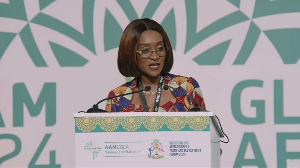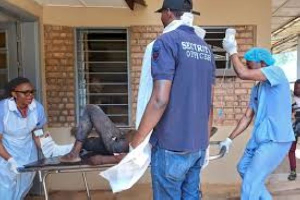According to the 2011 HIV Sentinel Surveillance (HSS) report, Cape Coast, the Central Regional capital, recorded Ghana's highest HIV rate, leaping from a prevalence of 2.2 percent in 2010 to 9.6 percent in 2011.
According to the report, the Central Region also recorded the highest HIV prevalence of 4.7 percent in 2011, indicating more than a 100 percent increase from 1.7 percent in 2010, in addition to being the region with the highest rate of syphilis in the country.
These facts were announced on Tuesday by Dr. Angela El-Adas, Director General of the Ghana AIDS Commission, during this year’s World AIDS Day celebration in Cape Coast. The theme of this year’s AIDS day was, "Getting to Zero: Zero new HIV infections, Zero AIDS related deaths, Zero discrimination," with Ghana’s sub-theme being “Accelerating to Zero together.”
The event, which was marked with regional durbars throughout the country, was observed by scores of people from across the region, including Ministers of state and other government officials, traditional leaders, and students.
Dr. El-Adas attributed the region’s high HIV rate to a number of factors such as the influx of young, healthy migrant workers from the Western Region who moved to the Central Region, where there are large numbers of vulnerable young people, in search of oil work.
Another reason, she said, is that many Central Region residents are mired in poverty and have endured intermittent food insecurity. Conditions such as these invariably increased sexual vulnerability and sex work, both of which tend to increase HIV transmission.
“The choice of Central Region was therefore deliberate to create the much needed awareness, expand and scale up interventions and services that would ensure a reduction in the HIV prevalence in the region, hopefully in 2013”, she said.
El-Adas noted that AIDS was at present the leading cause of death for women of reproductive age worldwide with unsafe sex being the main risk factor driving the epidemic in developing countries.
She said Ghana had in excess of 212,000 adults and children living with HIV, over 60 per cent of whom are women. About 13 per cent of persons living with HIV are between the ages of 15 to 24, and this demographic accounted for about 37 per cent of all new infections in 2011.
She said that in spite of the fact that over 75 percent of pregnant women with HIV receive services to prevent mother to child transmission, 25 percent do not, and over 170,000 children have been orphaned by HIV since the disease was discovered in Ghana.
El-Adas also noted that since the Commission’s Anti-Retroviral Treatment (ART) program began in 2003, a cumulative 73,000 HIV patients had benefitted from it with the majority of them alive and still receiving ART.
She expressed anxieties about the stigma and discrimination that persons living with HIV face and advised the general public to do away with such attitudes and welcome AIDS patients into society in order to make their lives comfortable and worth living. The Commission’s work is ongoing, she said.
The Central Regional Minister, Mrs. Ama Benyiwa-Doe called on all stakeholders involved to join forces with the Commission to help fight the HIV menace in the region and the nation at large.
A cake was cut to mark the Commission’s ten-year anniversary, which fell on the same day.
Health News of Wednesday, 5 December 2012
Source: FRANK OWUSU OBIMPEH
















